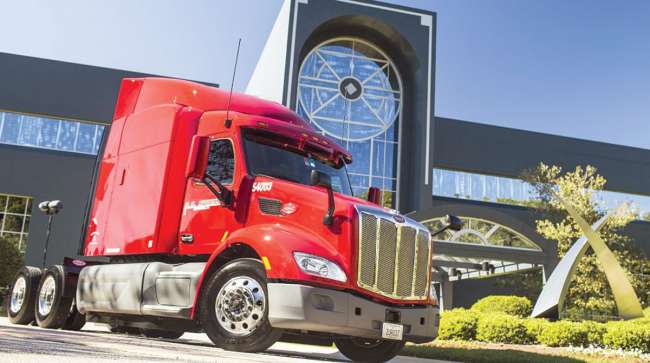Staff Reporter
U.S. Xpress Reports Revenue Gain, Earnings Loss for Q4

[Stay on top of transportation news: Get TTNews in your inbox.]
U.S. Xpress Enterprises increased revenue but earnings fell during the fourth quarter of 2022, the company reported Feb. 9.
The Chattanooga, Tenn.-based truckload carrier posted a net loss of $10.5 million, or a loss of 22 cents a diluted share, for the three months ending Dec. 31. That compared with a loss of $4.98 million, or a loss of 10 cents, during the same time the previous year. Total operating revenue increased 2.1% to $542.5 million from $531.6 million.
Wall Street analysts had been looking for negative 12 cents per share and quarterly revenue of $521.09 million, according to Zacks Consensus Estimate.
“2022 was a year of transition for U.S. Xpress as we executed our realignment plan,” CEO Eric Fuller said during a call with investors Feb. 9. ”We transitioned our OTR operations back to a more traditional model focused on ensuring freight is delivered on time and in a cost-effective manner for our customers, and recently transitioned all truckload and brokerage operations under one leader, Justin Harness.”

Fuller
U.S. Xpress on Sept. 7 announced a realignment plan focused on improving operating profitability and cash flow. Cost savings related to the plans was approximately $8 million in the fourth quarter. The truckload segment portion of that plan was completed during the quarter, but sequential rate pressure from spot market exposure and higher fuel costs more than offset progress that was made.
“The heavy lifting associated with our realignment plan is complete, and we began to see cost savings in the fourth quarter from the actions we have taken since early September,” Fuller said. “Overall, I was pleased with the progress we made in our OTR division and with our cost takeout initiatives from our realignment plan.
“Improvement in underlying metrics including fleet availability, service level and utilization give me the confidence that we are moving in the right direction.”
Fuller added that conversations with customers continue to evolve. He noted, though, that the back-to-basics message and progress has been resonating with them and have been instrumental in helping to add incremental load volume despite the weak freight market.
“Feedback from our customers indicate that many are still working through some level of inventory destocking,” Fuller said. “Our pipeline of OTR freight opportunities is extremely robust, and we expect to make meaningful progress reducing our spot market exposure as we navigate through bid season and begin to service new awards. Our customer base is heavily focused on industry-leading companies ... including discount retail, consumer nondurables and retail grocery.”
For the year, U.S. Xpress reported a net loss of $38.9 million, or a loss of 79 cents a share, on record revenue of $2.16 billion, compared with net income of $11.1 million, or 21 cents, on revenue of $1.95 billion in 2021.

Host Seth Clevenger speaks with autonomous vehicle pioneer Don Burnette about the pros and cons of driverless cars and trucks. Hear the program above and at RoadSigns.TTNews.com.
Third of a three-part series on autonomous vehicles. Hear Part I here, and Part II here.
Truckload revenue in Q4 increased 5.7% to $464.1 million from $419.7 million year-over-year. The gain primarily was due to a rise in average available tractors and higher overall average revenue per tractor per week. Operating income decreased to a loss of $11.9 million from a loss of $8.23 million. This was due to spot market exposure and weaker overall freight volumes causing the average revenue per mile in the over-the-road division to decrease by 6 cents per mile.
Brokerage revenue fell 29.9% to $78.4 million from $111.9 million. The decline was due to a decrease in load count, which offset an 18.3% increase in revenue per load. The year-over-year decline in load count mostly was because of an increase in allocation of available freight to the asset-based over-the-road fleet. Operating income grew 99.4% to $6.22 million from $3.12 million.
J.P. Morgan noted in a report that high exposure to the spot market hindered profitability. The financial services company expects the carrier to perform in line with peers going forward but noted a turnaround and return to profitability is more contingent on freight market conditions such as an expected spot market recovery in Q2.
“The company’s over-the-road business remains the primary earnings drag based on weak utilization rates and elevated spot exposure,” J.P. Morgan analyst Brian Ossenbeck wrote in the report. “The OTR outlook is almost entirely dependent on broader freight market conditions. Management expects a soft market through [the first half of 2023] although there were encouraging signs of a bottom in rates and demand during January. Overall, it still appears that the turnaround and return to profitability at U.S. Xpress is more contingent on freight market conditions than peers.”
U.S. Xpress ranks No. 23 on the Transport Topics Top 100 list of the largest for-hire carriers in North America and No. 54 on the TT Top 100 list of the largest logistics companies in North America.
Want more news? Listen to today's daily briefing below or go here for more info:



